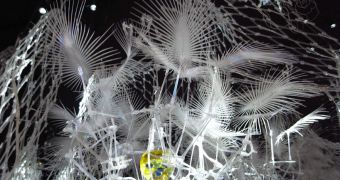The University of Greenwich’s School of Architecture & Construction could create 'living' materials to cover buildings and help fight the effects of climate change, by using ethical synthetic biology.
For the development of materials that could produce water in the desert or biofuels out of sunlight, a collaboration between researchers from the University of Greenwich and others at the University of Southern Denmark, University of Glasgow and University College London (UCL) is already in place.
And when architecture meets new technologies, amazing things can happen, so the researchers thought that it would be interesting to work with an architectural practice and a building materials’ manufacturer.
Their idea is to use protocells to fix carbon from the atmosphere or to create a coral-like skin, which could protect buildings.
Protocells are bubbles of oil in a watery fluid, very sensitive to light or to different chemicals, which allow the exchange of soluble chemicals between the drops and their surrounding solution.
According to Professor Neil Spiller, an architect and the new head of the University of Greenwich’s School of Architecture & Construction, the researchers were looking at methods of using responsive protocells to cover cities in an ethical, ecological and sustainable way.
‘’We want to use ethical synthetic biology to create large-scale, real world applications for buildings,’’ he said.
The Center for Fundamental Living Technology at the University of Southern Denmark succeeded in making cells capture the CO2 from the solution surrounding the protocells, and converting it into materials containing carbon, which could be used to fix carbon so that carbon-negative architecture can be built.
The best example of all this is the installation displayed in the Canadian Pavilion in the Venice Biennale 2010, Hylozoic Ground, created by Canadian architect Philip Beesley.
This exemplifies the way that protocells can be used to create carbon-negative architectures, AlphaGalileo reports.
The protocells within the installation designed by Dr Rachel Armstrong, Teaching Fellow at UCL’s Bartlett School of Architecture, recycle the carbon dioxide that the visitors exhale, and turn it into carbon-containing solids.
The city of Venice could apply this technology and use similar deposits to stabilize its foundations, by growing an artificial limestone reef beneath it.
Professor Spiller said that “we want to use protocell bubbles to fix carbon or precipitate skin that we can then develop into a coral-like architecture, which could petrify the piles that support Venice to spread the structural weight-load of the city.”
Watch a video of the Canadian Pavilion in the Venice Biennale 2010, Hylozoic Ground:

 14 DAY TRIAL //
14 DAY TRIAL //